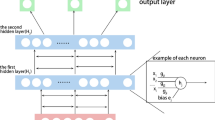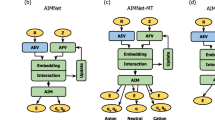Abstract
In this study, we developed a neural network that incorporates a fully connected layer with a convolutional layer to predict the nuclear charge radii based on the relationships between four local nuclear charge radii. The convolutional neural network (CNN) combines the isospin and pairing effects to describe the charge radii of nuclei with \(A \ge\) 39 and \(Z \ge\) 20. The developed neural network achieved a root mean square (RMS) deviation of 0.0195 fm for a dataset with 928 nuclei. Specifically, the CNN reproduced the trend of the inverted parabolic behavior and odd–even staggering observed in the calcium isotopic chain, demonstrating reliable predictive capability.





Similar content being viewed by others
Data availability
The data that support the findings of this study are openly available in Science Data Bank at https://www.doi.org/10.57760/sciencedb.j00186.00238 and https://cstr.cn/31253.11.sciencedb.j00186.00238.
References
A. Bohr, B.R. Mottelson, Nuclear Structure, vol. One Benjamin, New York (1969). https://doi.org/10.1063/1.3022342
H. Limura, F. Buchinger, Charge radii in macroscopic microscopic mass models of reflection asymmetry. Phys. Rev. C 78, 067301 (2008). https://doi.org/10.1103/PhysRevC.78.067301
S. Geldhof, M. Kortelainen, O. Beliuskina et al., Impact of nuclear deformation and pairing on the charge radii of palladium isotopes Phys. Rev. Lett. 128, 152501 (2022). https://doi.org/10.1103/PhysRevLett.128.152501
L.B. Wang, P. Mueller, K. Bailey et al., Laser spectroscopic determination of the \({}^{6}\)He nuclear charge radius. Phys. Rev. Lett. 93, 142501 (2004). https://doi.org/10.1103/PhysRevLett.93.142501
N. Wang, T. Li, Shell and isospin effects in nuclear charge radii. Phys. Rev. C 88, 011301 (2013). https://doi.org/10.1103/PhysRevC.88.011301
T.Q. Liang, J. Liu, Z.Z. Ren et al., Elastic electron scattering form factors of deformed exotic Xe isotopes. Phys. Rev. C 98, 044310 (2018). https://doi.org/10.1103/PhysRevC.98.044310
H. De Vries, C.W. De Jager, C. De Vries, Nuclear charge-density-distribution parameters from elastic electron scattering. At. Data Nucl. Data Tables 36, 495 (1987). https://doi.org/10.1016/0092-640X(87)90013-1
K. Heilig, A. Steudel, Changes in mean-square nuclear charge radii from optical isotope shifts. At. Data Nucl. Data Tables 14, 613 (1974). https://doi.org/10.1016/S0092-640X(74)80006-9
P. Aufmuth, K. Heilig, A. Steudel, Changes in mean-square nuclear charge radii from optical isotope shifts. At. Data Nucl. Data Tables 37, 455 (1987). https://doi.org/10.1016/0092-640X(87)90028-3
R. Engfer, H. Schneuwly, J.L. Vuileumier et al., Charge-distribution parameters, isotope shifts, isomer shifts, and magnetic hyperfine constants from muonic atoms. At. Data Nucl. Data Tables 14, 509 (1974). https://doi.org/10.1016/S0092-640X(74)80003-3
G. Fricke, C. Bernhardt, K. Heilig et al., Nuclear ground state charge radii from electromagnetic interactions. At. Data Nucl. Data Tables 60, 177 (1995). https://doi.org/10.1006/adnd.1995.1007
E. Boehm, P.L. Lee, Changes of mean-square nuclear charge radii from isotope shifts of electronic \(K_{\alpha }\) X-rays. At. Data Nucl. Data Tables 14, 605 (1974). https://doi.org/10.1016/S0092-640X(74)80005-7
I. Angeli, K.P. Marinova, Table of experimental nuclear ground state charge radii: an update. At. Data Nucl. Data Tables 99, 69 (2013). https://doi.org/10.1016/j.adt.2011.12.006
T. Li, Y. Luo, N. Wang, Compilation of recent nuclear ground state charge radius measurements and tests for models. At. Data Nucl. Data Tables 140, 101440 (2021). https://doi.org/10.1016/j.adt.2021.101440
S. Goriely, S. Hilaire, M. Girod et al., First Gogny–Hartree–Fock–Bogoliubov nuclear mass model. Phys. Rev. Lett. 102, 242501 (2009). https://doi.org/10.1103/PhysRevLett.102.242501
S. Goriely, N. Chamel, J.M. Pearson, Further explorations of Skyrme–Hartree–Fock–Bogoliubov mass formulas. XII. Stiffness and stability of neutron-star matter. Phys. Rev. C 82, 035804 (2009). https://doi.org/10.1103/PhysRevC.82.035804
L.S. Geng, H. Toki, S. Sugimoto et al., Relativistic mean field theory for deformed nuclei with pairing correlations. Prog. Theor. Phys. 110, 921 (2003). https://doi.org/10.1143/PTP.110.921
P.W. Zhao, Z.P. Li, J.M. Yao et al., New parametrization for the nuclear covariant energy density functional with a point-coupling interaction. Phys. Rev. C 82, 054319 (2010). https://doi.org/10.1103/PhysRevC.82.054319
Y. Funaki, T. Yamada, H. Horiuchi et al., \(\alpha\)-particle condensation in \({}^{16}\)O studied with a full four-body orthogonality condition model calculation. Phys. Rev. Lett. 101, 082502 (2008). https://doi.org/10.1103/PhysRevLett.101.082502
S.Q. Zhang, J. Meng, S.G. Zhou et al., Isospin and \(Z^{1/3}\)-dependence of the nuclear charge radii. Eur. Phys. J. A 13, 285 (2002). https://doi.org/10.1007/s10050-002-8757-6
Y.A. Lei, Z.H. Zhang, J.Y. Zeng, Improved \(Z^{1/3}\) law of nuclear charge radius. Commun. Theor. Phys. 51, 123 (2009). https://doi.org/10.1088/0253-6102/51/1/23
B. Nerlo-Pomorska, K. Pomorski, Isospin dependence of nuclear radius. Z. Phys. A 344, 359 (1993). https://doi.org/10.1007/BF01283190
B. Nerlo-Pomorska, K. Pomorski, Simple formula for nuclear charge radius. Z. Phys. A 348, 169 (1994). https://doi.org/10.1007/BF01291913
G. Royer, R. Rousseau, On the liquid drop model mass formulae and charge radii. Eur. Phys. J. A 42, 541 (2009). https://doi.org/10.1140/epja/i2008-10745-8
Z.Q. Sheng, G.W. Fan, J.F. Qian et al., An effective formula for nuclear charge radii. Eur. Phys. J. A 51, 4 (2015). https://doi.org/10.1140/epja/i2015-15040-1
J. Piekarewicz, M. Centelles, X. Roca-Maza et al., Garvey–Kelson relations for nuclear charge radii. Eur. Phys. J. A 46, 379 (2010). https://doi.org/10.1140/epja/i2010-11051-8
B.H. Sun, Y. Lu, J.P. Peng et al., New charge radius relations for atomic nuclei. Phys. Rev. C 90, 054318 (2014). https://doi.org/10.1103/PhysRevC.90.054318
M. Bao, Y.Y. Zong, Y.M. Zhao et al., Local relations of nuclear charge radii. Phys. Rev. C 102, 014306 (2020). https://doi.org/10.1103/PhysRevC.102.014306
Y.G. Ma, Hypernuclei as a laboratory to test hyperon-nucleon interactions. Nucl. Sci. Tech. 34, 97 (2023). https://doi.org/10.1007/s41365-023-01248-6
R. Wang, Y.G. Ma, R. Wada et al., Nuclear liquid–gas phase transition with machine learning. Phys. Rev. Res. 2, 043202 (2020). https://doi.org/10.1103/PhysRevResearch.2.043202
J. Steinheimer, L. Pang, K. Zhou et al., A machine learning study to identify spinodal clumping in high energy nuclear collisions. JHEP 12, 122 (2019). https://doi.org/10.1007/JHEP12%282019%29122
Y.G. Ma, Effects of \(\alpha\)-clustering structure on nuclear reaction and relativistic heavy-ion collisions. Nuclear Techniques 46(8), 080001 (2023). https://doi.org/10.11889/j.0253-3219.2023.hjs.46.080001 (in Chinese)
R. Utama, J. Piekarewicz, H.B. Prosper, Nuclear mass predictions for the crustal composition of neutron stars: a Bayesian neural network approach. Phys. Rev. C 93, 014311 (2016). https://doi.org/10.1103/PhysRevC.93.014311
R. Utama, J. Piekarewicz, Refining mass formulas for astrophysical applications: a Bayesian neural network approach. Phys. Rev. C 96, 044308 (2017). https://doi.org/10.1103/PhysRevC.96.044308
Z.M. Niu, H.Z. Liang, B.H. Sun et al., High precision nuclear mass predictions towards a hundred kilo-electron-volt accuracy. Sci. Bull. 63, 759 (2018). https://doi.org/10.1016/j.scib.2018.05.009
W.B. He, Y.G. Ma, L.G. Pang et al., High-energy nuclear physics meets machine learning. Nucl. Sci. Tech. 34, 88 (2023). https://doi.org/10.1007/s41365-023-01233-z
W.B. He, Q.F. Li, Y.G. Ma et al., Machine learning in nuclear physics at low and intermediate energies. Sci. China Phys. Mech. Astron. 66, 282001 (2023). https://doi.org/10.1007/s11433-023-2116-0
J.J. He, W.B. He, Y.G. Ma et al., Machine-learning-based identification for initial clustering structure in relativistic heavy-ion collisions. Phys. Rev. C 104, 044902 (2021). https://doi.org/10.1103/PhysRevC.104.044902
Y.L. Cheng, S.Z. Shi, Y.G. Ma et al., Examination of nucleon distribution with Bayesian imaging for isobar collisions. Phys. Rev. C 107, 064909 (2023). https://doi.org/10.1103/PhysRevC.107.064909
S. Akkoyun, T. Bayram, S.O. Kara et al., An artificial neural network application on nuclear charge radii. J. Phys. G 40, 055106 (2013). https://doi.org/10.1088/0954-3899/40/5/055106
D. Wu, C.L. Bai, H. Sagawa et al., Calculation of nuclear charge radii with a trained feed-forward neural network. Phys. Rev. C 102, 054323 (2020). https://doi.org/10.1103/PhysRevC.102.054323
R. Utama, W.C. Chen, J. Piekarewicz, Nuclear charge radii: density functional theory meets Bayesian neural networks. J. Phys. G 43, 114002 (2016). https://doi.org/10.1088/0954-3899/43/11/114002
Z.M. Niu, H.Z. Liang, B.H. Sun et al., Predictions of nuclear \(\beta\)-decay half-lives with machine learning and their impact on r-process nucleosynthesis. Phys. Rev. C 99, 064307 (2019). https://doi.org/10.1103/PhysRevC.99.064307
L. Neufcourt, Y.C. Cao, W. Nazarewicz et al., Bayesian approach to model-based extrapolation of nuclear observables. Phys. Rev. C 98, 034318 (2018). https://doi.org/10.1103/PhysRevC.98.034318
X.X. Dong, A. Rong, J.X. Lu et al., Novel Bayesian neural network based approach for nuclear charge radii. Phys. Rev. C 105, 014308 (2022). https://doi.org/10.1103/PhysRevC.105.014308
Z.M. Niu, Z.L. Zhu, Y.F. Niu et al., Radial basis function approach in nuclear mass predictions. Phys. Rev. C 88, 024325 (2013). https://doi.org/10.1103/PhysRevC.88.024325
J.S. Zheng, N.Y. Wang, Z.Y. Wang et al., Mass predictions of the relativistic mean-field model with the radial basis function approach. Phys. Rev. C 90, 014303 (2014). https://doi.org/10.1103/PhysRevC.90.014303
Z.P. Gao, Y.J. Wang, H.L. Lü et al., Machine learning the nuclear mass. Nucl. Sci. Tech. 32, 109 (2021). https://doi.org/10.1007/s41365-021-00956-1
N. Wang, M. Liu, Nuclear mass predictions with a radial basis function approach. Phys. Rev. C 84, 051303(R) (2011). https://doi.org/10.1103/PhysRevC.84.051303
T.S. Shang, J. Li, Z.M. Liu, Prediction of nuclear charge density distribution with feedback neural network. Nucl. Sci. Tech. 33, 153 (2022). https://doi.org/10.1007/s41365-022-01140-9
X.X. Dong, A. Rong, J.X. Lu et al., Nuclear charge radii in Bayesian neural networks revisited. Phys. Lett. B 838, 137726 (2023). https://doi.org/10.1016/j.physletb.2023.137726
Y.Y. Li, F. Zhang, J. Su, Improvement of the Bayesian neural network to study the photoneutron yield cross sections. Nucl. Sci. Tech. 33, 135 (2022). https://doi.org/10.1007/s41365-022-01131-w
K. Mills, M. Spanner, I. Tamblyn, Deep learning and the Schrödinger equation. Phys. Rev. A 96, 042113 (2017). https://doi.org/10.1103/PhysRevA.96.042113
K. Ryczko, D.A. Strubbe, I. Tamblyn, Deep learning and density-functional theory. Phys. Rev. A 100, 022512 (2019). https://doi.org/10.1103/PhysRevA.100.022512
G.T. Garvey, I. Kelson, New nuclidic mass relationship. Phys. Rev. Lett. 16, 197 (1966). https://doi.org/10.1103/PhysRevLett.16.197
G.T. Garvey, W.J. Gerace, R.L. Jaffe et al., Set of nuclear-mass relations and a resultant mass table. Rev. Mod. Phys. 41, S1 (1969). https://doi.org/10.1103/RevModPhys.41.S1
Y. LeCun, B. Boser, J.S. Denker et al., Backpropagation applied to handwritten zip code recognition. Neural Comput. 1, 541 (1989). https://doi.org/10.1162/neco.1989.1.4.541
I. Angeli, Effect of valence nucleons on RMS charge radii and surface thickness. J. Phys. G: Nucl. Part. Phys. 17, 439 (1991). https://doi.org/10.1088/0954-3899/17/4/006
R. An, X.X. Dong, L.G. Cao et al., Local variations of charge radii for nuclei with even Z from 84 to 120. Commun. Theor. Phys. 75, 035301 (2023). https://doi.org/10.1088/1572-9494/acb58b
G.A. Lalazissis, M.M. Sharma, P. Ring, Rare-earth nuclei: radii, isotope-shifts and deformation properties in the relativistic mean-field theory. Nucl. Phys. A 597, 35 (1996). https://doi.org/10.1016/0375-9474(95)00436-X
R.F. Casten, Possible unified interpretation of heavy nuclei. Phys. Rev. Lett. 54, 1991 (1985). https://doi.org/10.1103/PhysRevLett.54.1991
T. Togashi, Y. Tsunoda, T. Otsuka et al., Quantum phase transition in the shape of Zr isotopes. Phys. Rev. Lett. 117, 172502 (2016). https://doi.org/10.1103/PhysRevLett.117.172502
B.A. Marsh, T.D. Goodacre, S. Sels et al., Characterization of the shape-staggering effect in mercury nuclei. Nature Phys. 14, 1163 (2018). https://doi.org/10.1038/s41567-018-0292-8
S. Péru, S. Hilaire, S. Goriely et al., Description of magnetic moments within the Gogny Hartree–Fock-Bogolyubov framework: application to Hg isotopes. Phys. Rev. C 104, 024328 (2021). https://doi.org/10.1103/PhysRevC.104.024328
R. An, L.S. Geng, S.S. Zhang, Novel ansatz for charge radii in density functional theories. Phys. Rev. C 102, 024307 (2020). https://doi.org/10.1103/PhysRevC.102.024307
P.G. Reinhard, W. Nazarewicz, Toward a global description of nuclear charge radii: exploring the Fayans energy density functional. Phys. Rev. C 95, 064328 (2017). https://doi.org/10.1103/PhysRevC.95.064328
Author information
Authors and Affiliations
Contributions
All authors contributed to the study conception and design. Material preparation, data collection and analysis were performed by Ying-Yu Cao, Jian-You Guo and Bo Zhou. The first draft of the manuscript was written by Ying-Yu Cao and all authors commented on previous versions of the manuscript. All authors read and approved the final manuscript.
Corresponding author
Ethics declarations
Bo Zhou is an editorial board member for Nuclear Science and Techniques and was not involved in the editorial review, or the decision to publish this article.
Conflict of interests
All authors declare that there are no competing interests.
Additional information
This work was supported by Shanghai “Science and Technology Innovation Action Plan” Project (No. 21ZR140950).
Rights and permissions
Springer Nature or its licensor (e.g. a society or other partner) holds exclusive rights to this article under a publishing agreement with the author(s) or other rightsholder(s); author self-archiving of the accepted manuscript version of this article is solely governed by the terms of such publishing agreement and applicable law.
About this article
Cite this article
Cao, YY., Guo, JY. & Zhou, B. Predictions of nuclear charge radii based on the convolutional neural network. NUCL SCI TECH 34, 152 (2023). https://doi.org/10.1007/s41365-023-01308-x
Received:
Revised:
Accepted:
Published:
DOI: https://doi.org/10.1007/s41365-023-01308-x




